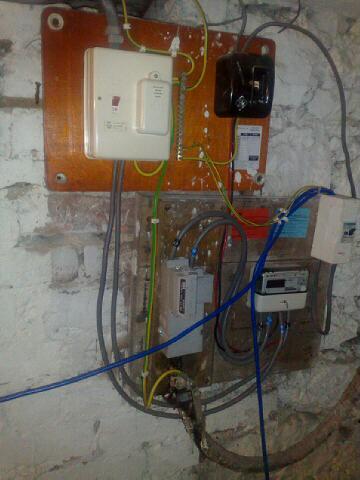Hello All
This is my first post so here goes. I have purchased a new house with a basement. After having a flood & the power going out. The dno replaced the cut out from 60A to a new 100A and upgraded the tails between it and the meter to 25mm. I now have 16mm tails going from the meter to a wylex 60A fused switch. My concern is that from this switch runs a 16mm two core pvc cable through the basement and up into the utility room a cable run of just over 30ft to a wlylex CU that has a 100A isolator and a range of MCB's with no RCD protection. Also have noticed that from the Main earthing terminal 10mm cable is used for the main protective bonding of water pipes and metal gas pipe, but the earth connection at the CU is not even 10mm, possibly as small as 4mm.
A friend ( not an electrician) advised that they thought the earth should be 16mm to the CU especially over such a distance and that the cable between the meter and the CU via the fused Switch should be 25mm tails. Also mentioned that he thought the 60A fused switch should be replaced be some kind of 100A rcd device incase the cable is punctured as runs exposed at head height in the basement for 24 ft before going up through floor into utility room.
Having looked at the forum postings i thought it sensible to ask what you all think. Should I also have Rcd's added to CU to protect final circuits?
Really appreciate any advise. I have attached a picture of the basement setup which includes other bits that have been switched off for now.
This is my first post so here goes. I have purchased a new house with a basement. After having a flood & the power going out. The dno replaced the cut out from 60A to a new 100A and upgraded the tails between it and the meter to 25mm. I now have 16mm tails going from the meter to a wylex 60A fused switch. My concern is that from this switch runs a 16mm two core pvc cable through the basement and up into the utility room a cable run of just over 30ft to a wlylex CU that has a 100A isolator and a range of MCB's with no RCD protection. Also have noticed that from the Main earthing terminal 10mm cable is used for the main protective bonding of water pipes and metal gas pipe, but the earth connection at the CU is not even 10mm, possibly as small as 4mm.
A friend ( not an electrician) advised that they thought the earth should be 16mm to the CU especially over such a distance and that the cable between the meter and the CU via the fused Switch should be 25mm tails. Also mentioned that he thought the 60A fused switch should be replaced be some kind of 100A rcd device incase the cable is punctured as runs exposed at head height in the basement for 24 ft before going up through floor into utility room.
Having looked at the forum postings i thought it sensible to ask what you all think. Should I also have Rcd's added to CU to protect final circuits?
Really appreciate any advise. I have attached a picture of the basement setup which includes other bits that have been switched off for now.


